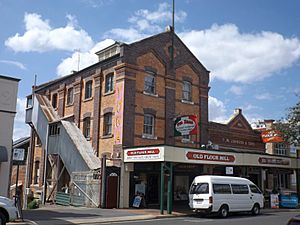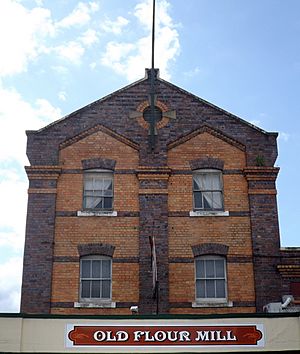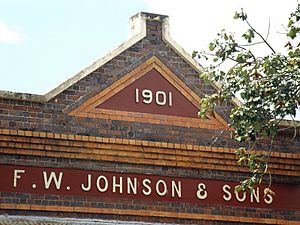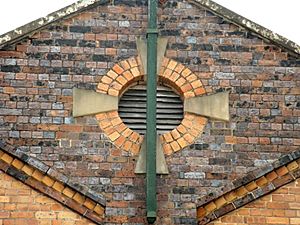Flour Mill, Ipswich facts for kids
The Flour Mill is a special old building in Ipswich, Queensland, Australia. It's located at 231 Brisbane Street. This building was designed by an architect named George Brockwell Gill and was built between 1901 and 1902. It used to be a place where flour was made from grain. Over the years, it has been known by other names like Bridal Mill, F.W. Johnson and Sons Motor Showroom, and Old Flour Mill. Because of its history and unique design, it was added to the Queensland Heritage Register on 21 October 1992, meaning it's protected for future generations to see.
Quick facts for kids Flour Mill, Ipswich |
|
|---|---|

Building in 2015
|
|
| Location | 231 Brisbane Street, Ipswich, City of Ipswich, Queensland, Australia |
| Design period | 1900 - 1914 (early 20th century) |
| Built | 1901 - 1902 |
| Architect | George Brockwell Gill |
| Official name: Flour Mill, Bridal Mill, F.W. Johnson and Sons Motor Showroom, Old Flour Mill | |
| Type | state heritage (built) |
| Designated | 21 October 1992 |
| Reference no. | 600556 |
| Significant period | 1901, 1902, 1910, 1920s, 1993 (fabric) 1902-1910, 1910-1926, 1935 (historical) |
| Significant components | store/s / storeroom / storehouse, mill |
| Lua error in Module:Location_map at line 420: attempt to index field 'wikibase' (a nil value). | |
Contents
The Mill's Early Days
The Flour Mill was built between 1901 and 1902 for the Ipswich Milling Company Ltd. It was one of many flour mills connected to Francis Kates, who was a Member of the Queensland Legislative Assembly. This means he was a person elected to help make laws for Queensland. The architect for the mill was G.B. Gill, and the builders were Worley and Whitehead.
Francis Kates and His Mills
Francis Kates was born in Berlin and moved to Queensland in 1858. He came from a family of millers. He started building flour mills, with his first one in Allora in 1871. As a politician, he cared about farming and wanted Queensland to grow more of its own wheat. The Ipswich mill was said to be his eighth mill! His son, Francis Henry Kates, owned the Ipswich property.
How the Mill Worked
When the mill was finished in 1902, it had a basement and three floors for milling. A steam engine from America powered the mill, and a boiler made in Australia used coal from North Ipswich. There was also a brick extension at the back, likely for the boiler room.
A large shed made of corrugated iron and timber was at the back for storing grain. This shed was connected to a railway line, so grain could arrive in bags. The mill could make about 35 to 40 tonnes of flour every week, which was sold under the name "Snowcloud." A single-story section on the side was used to store the flour.
Even though most grain came from places like Allora, the company encouraged local farmers to grow wheat. They even offered to sell seeds at cost price, hoping to save money on transport.
Changes Over Time
Francis Kates passed away in 1903, but his son continued to own the Ipswich property. In 1905, the mill was advertised as "Wigfull and Bland, Ipswich Flour Mills" and used a different brand name, "Heatherbell."
New Owners and Uses
In May 1910, a company called Cribb and Foote bought the property. They used it for different departments while their new building was being constructed. After that, it became their Stove Department. They added an awning with fancy timber brackets over the footpath.
In 1926, the Johnson family bought the building and turned it into a car showroom. Later, in September 1935, the radio station 4IP started broadcasting from the top floor. People could get to it using an outside staircase. An awning was also added across the front of the building, possibly in the late 1920s.
Later Life of the Building
After being a car showroom and radio station, the mill building was used for other things. It housed "Paddy's Market" and was used to store furniture. In the mid-1980s, the top floor became a martial arts school, and the lower floors were used for a bridal shop and a fabric shop.
In 1985, Beverley de Witt bought the property. In 1993, it was changed into a restaurant, a function room for events, and a shopping area. A new two-story section was built at the back to hold the function room.
What the Building Looks Like
The Flour Mill is actually a group of buildings connected together. The main part, where the milling used to happen, has three floors plus a basement. Because the ground slopes, the basement is above ground level at the back.
Main Mill Section
This part of the building is made of strong brickwork with different colors (polychrome brickwork). It has decorative pillars (pilasters), arches, and lines of bricks (string courses) that make it look nice. There are pairs of windows on the top two floors at the front and five windows on each side. The roof is made of corrugated iron and has a raised timber vent for air. The basement area at the back now has an outdoor eating space on top.
The front of the old mill section now has a retail shop on the ground and first floors, connected by inside stairs. The third floor of the mill can be reached by an outside staircase.
Newer and Older Parts
At the back of the original mill, there's a newer part with a brick base and an upper level covered in corrugated iron. This part now holds a function room.
Attached to the side of the mill is a single-story section, which used to be the flour store. It has a decorative wall (parapet) at the top with the date 1901. Behind this is the old grain storage shed, also covered in corrugated iron. The single-story section now has a sandwich shop and a walkway leading to stairs. These stairs go up to a restaurant and down to a shopping arcade.
A long roof (awning) stretches across the front of the whole building over the footpath. The ceiling of one part of the awning is made of decorative pressed metal, and the other part is ripple iron. Above both shop fronts, there are colored glass windows called fanlights.
Why the Flour Mill is Important
The Flour Mill was added to the Queensland Heritage Register on 21 October 1992. This means it's considered very important to Queensland's history and culture for several reasons:
A Unique Building
The mill is special because it's an industrial building (a factory) located right in the middle of a city's main business area (CBD). This was uncommon when it was built in 1902.
Beautiful Design
Even though it was built for a practical purpose like making flour, the mill is very well-designed and decorated. People value its beautiful look, and it helps make the "Top of Town" shopping area in Ipswich look historic and interesting.
Connections to Key People and Groups
The Flour Mill has strong links to important people and groups in Queensland's history:
- It's connected to Francis Kates and his son, who were important in developing flour mills.
- It was used by Cribb and Foote, a major early retail company, as their stove department.
- The early radio station 4IP started broadcasting from here in 1935.
- It's a great example of the well-designed brick buildings created by architect George Brockwell Gill.





